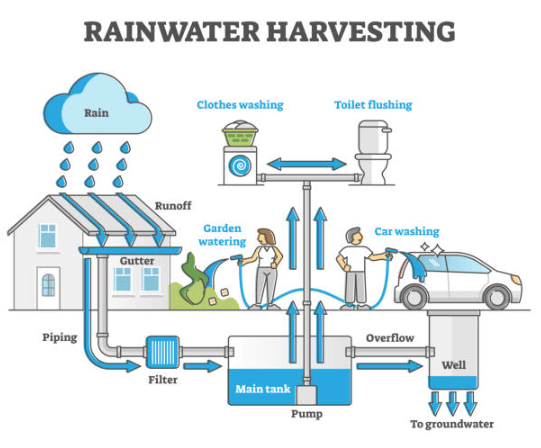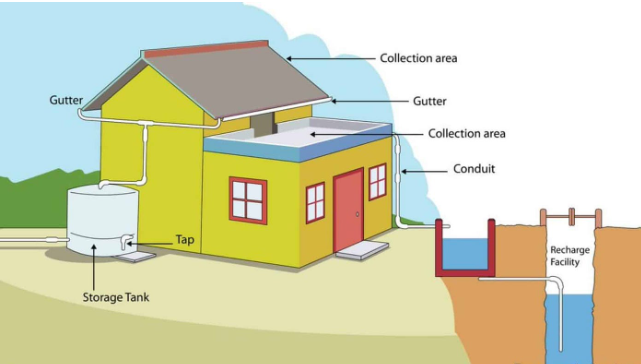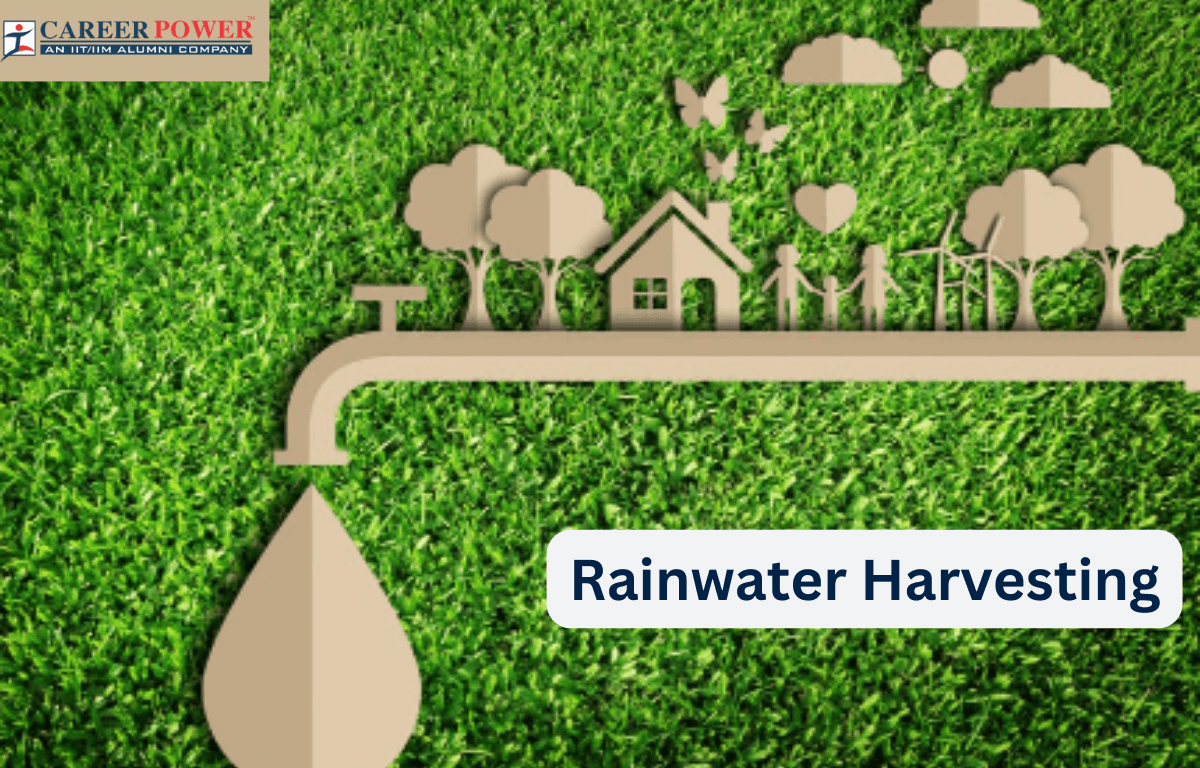As we all know water is very important for the survival of living organisms. All the water bodies such as rivers, streams, lakes, ponds, pools, polar ice caps, etc., collectively form the Hydrosphere. The Hydrosphere comprises water which is an inexhaustible natural resource. Water is present in the form of liquid above 0°C and below 100°C. 71%of Earth is covered by oceans which contain 97.5% of the total water. The land contains 2.5% of the total water. A major part (1.9% of the total) of water is present in the form of ice caps and glaciers. The remaining 0.6% of the total supports life, which is known to be freshwater (water with salt content less than 0.5%).
Rainwater Harvesting
More than 90% of the freshwater is found under the ground as Underground water. The remaining 10% of freshwater occurs as surface water (found in rivers, dams, lakes, and ponds), soil water, or as water vapours present in the atmosphere. Because of this, there is a scarcity of water in many places, so people in those places store the rainwater for further use through the process known as Rainwater Harvesting.
Rainwater harvesting is a simple effective method of collecting and storing rainwater to use it later. Rainwater harvesting is an important topic that is mentioned in both class 9th and 10th Biology sections. In class 10th it is the topic of the chapter “Management of Natural Resources” while in class 9th this topic is mentioned in the chapter called “Natural Resources”. We have discussed every important information about Rainwater Harvesting in our article. Hope the information mentioned in the article makes it easier for you to understand rainwater harvesting.
What is Rainwater Harvesting?
Rainwater harvesting is a technique that is used to capture, store and reutilize rainwater, by making water-harvesting structures such as dug-out wells, percolation pits, check dams, and lagoons. Rainwater harvesting can be beneficial for all regions, particularly in the region with a high scarcity of rainfall. Rajendra Singh, fondly known as “Water Man”, was awarded the Magsaysay Award in 2001 for his technique of harvesting rainwater. He has revived an age-old Indian technique of collecting rainwater in dams (Johads) to increase the level of the water table, which recharges the wells and restores greenery in Sirska Forest Hills in Rajasthan.
As we all know Rainwater Harvesting is an age-old practice in India. The water harvesting techniques depend on the location where it is to be used. Some of the ancient water harvesting structures used in different regions are tabulated below:
| Ancient Rainwater Harvesting Structures | |
| Regions | Ancient Water Harvesting Structures |
| Rajasthan | Khadin, Tanks, Nadis |
| Maharashtra | Bandharas, Tals |
| Madhya Pradesh and Uttar Pradesh | Bhundhis |
| Bihar | Ahars and Pynes |
| Himachal Pradesh | Kulhs |
| Jammu region | Ponds |
| Tamil Nadu | Eris (Tanks) |
| Kerala | Surangams |
| Karnataka | Kattas |
Rainwater Harvesting Diagram
The rainwater harvesting diagram which we have mentioned in our article shows the collection of rainwater on the rooftop, filtration through gutters and filters, storage in the tanks, and then finally used for various purposes like irrigation, flushing, car washing, etc.

Rainwater Harvesting Advantages
Rainwater harvesting offers a range of benefits that contributes to water sustainability, economic saving, environmental protection, etc. The technique of rain-water harvesting is very important in many ways, and some of them are mentioned below:
- Sustainable Water Source: Rainwater harvesting provides an additional water source, especially in regions facing water scarcity or drought.
- Flood Mitigation: Rainwater harvesting can play a role in mitigating urban flooding by capturing rainwater runoff from rooftops and diverting it away from streets and drainage systems.
- Cost Savings: By using rainwater for non-potable purposes like irrigation or flushing toilets, households and businesses can significantly reduce their water bills. It reduces the need for purchasing water, which results in potential cost savings.
- Environmental Benefits: Rainwater harvesting helps recharge groundwater, reduces soil erosion, and also decreases the strain on local water supplies.
- Groundwater recharge: By collecting rainwater, less pressure is put on underground aquifers and groundwater sources. Harvesting helps to maintain a balance of groundwater levels and prevents over-exploitation.
- Sustainable supply: Harvested water provides a local and sustainable source of water for non-portable uses, such as watering plants, washing cars and clothes, and cleaning.
- Water quality: Rainwater is generally free from contaminants often found in groundwater sources. Properly harvested and stored rainwater can be used for non-potable applications without the need for extensive treatments.
- Educational values: Implementing a rainwater harvesting system can raise awareness about water conservation and sustainable practices. It offers educational opportunities for individuals and helps communities to learn about water cycles and resource management.
Rainwater Harvesting Methods
The whole process of rainwater harvesting involves collecting and storing rainwater for various important uses. The choice of method depends on the factors like local climate, soil type, water demand, and available space. It’s very important to design rainwater harvesting systems based on these considerations to make them effective and sustainable. Some of the common methods are mentioned here:
- Rooftop Collection: The rooftop harvesting involves capturing rainwater on the rooftop and then channeling it into the storage tanks. Gutters, downspouts, and filters are used to direct and clean the water before storage.
- Surface Runoff Collection: The surface runoff collection method collects rainwater on the ground surface, and is then directed into the storage system such as ponds, reservoirs, or underground tanks.
- Rainwater Diversion: The rainwater diversion method involves using channels or pipes to direct rainwater into the paves or open areas and then passed to the storage tanks or recharge structures like boreholes or recharge pits.
- Check Dams: The check dams are small barriers built across small streams or seasonal watercourses to slow down and capture rainwater, allowing it to infiltrate the soil and recharge groundwater.
- Subsurface Dams: Underground barriers are constructed to slow down the flow of rainwater, which leads it to the pools and infiltrates the ground.
- Stormwater Harvesting: Collecting rainwater from urban stormwater drains and using it for non-potable purposes like irrigation, flushing toilets, or industrial processes.
- Green Roofs: In green roofs, people create vegetative roofs that absorb rainwater and provide insulation. It also reduces runoff and contributes to urban cooling
Traditional Rainwater Harvesting in India
In India, there has been an age-old tradition that the villages will have a pond or tank in which they collect rainwater during the rainy season. This pond water used to be a necessary part of the village life. Throughout the year, the stored water of the ponds is used for animals and for small irrigation programs. This water is even used by the village washerman as they wash the clothes in these ponds.
While in the foothills, the water from the springs is collected by small embankments. The spring water is diverted and transported by the hollow bamboo sticks. In Rajasthan underground tanks (tankas) were mostly known and Khadins were used for harvesting rainwater. Almost all the towns in Rajasthan have a number of tanks, Baolis, and Johads. All these structures provide the supply of water during water shortage periods.
Rainwater Harvesting Model
The rainwater harvesting system needs to be designed and customized based on local conditions and requirements. As rainwater harvesting can be done by various methods, and each method has its own model for harvesting rainwater. We have discussed one of them below.

Rooftop Collection System
A rooftop collection system refers to the process of capturing and sorting rainwater that falls on the rooftops for various irrigation or household needs.
- Roff catchment area: The surface area of the rooftop from which rainwater is collected.
- Gutter and Downspouts: Channels that direct rainwater from the roof to the storage tanks.
- Leaf screens or Filters: These prevent waste materials from entering the storage system.
Storage Tanks
Storage tanks are containers used to store liquids, such as water, chemical, and rainwater collected from the rooftop, for further use.
- Tank Material: The tanks are usually made up of plastic, concrete, or metal.
- Tank Capacity: The capacity of the tank is determined by rainfall patterns and water demands.
- First Flush Diverter: They divert the initial runoff (which can contain contaminants) away from the tank to ensure cleaner water storage.
Filter and Purification
Filter and Purification systems are used to clean and treat collected rainwater, removing impurities, and contaminants to make it safe for consumption or various purposes.
- Filtration system: The filtration system removes finer particles and debris from the collected water.
- UV Treatment or Chlorination: It is an optional step and provides additional disinfection to make water suitable for various uses.
Distribution System
The distribution system involves pipes, pumps, and other infrastructures for the transportation of collected and purified rainwater from storage tanks to different points for various uses.
- Pump: The pumps are used if needed, and are used to distribute water to desired locations.
- Overflow Outlets: These prevent the tanks from overflowing during heavy rainfall.
End Use
“End Use” refers to the final purpose for which the collected, filtered, and distributed rainwater is utilized. This can include activities such as drinking, cooking, irrigation, cleaning, etc.
- Non-portable Uses: Used for watering plants, washing clothes or laundry, flushing toilets, and cleaning.
- Portable Uses: These are only applied if the water has gone through advanced treatment. Portable uses are; drinking and cooking.
Maintenance
Maintenance involves regular checks, cleaning, and repair of the entire rooftop collection system. Which involves storage tanks, filters, purification units, and many more. It helps to ensure the continued availability of clean rainwater for different use.
- Regulating cleaning: Ensuring filters, gutters, and tanks are free from debris and contaminants.
- Inspecting Pumps and Valves: The pumps should be checked properly for proper functioning.
Monitoring and Management
The monitoring and management involve overseeing the performance of the rooftop collection system. Which includes tracking water quantity, storage levels, and distribution efficiency.
- Monitoring water level: It means keeping track of water levels in the tanks.
- Rainfall Forecasting: This helps in planning water usage based on the expected rainfall.
Benefits of Rainwater Harvesting
Water Conservation: Rainwater harvesting helps reduce the demand on traditional water sources, such as rivers and groundwater. This, in turn, preserves these precious resources and helps prevent over-extraction and depletion.
Reduced Energy Consumption: Treating and distributing water to homes and businesses is energy-intensive. By using harvested rainwater for certain applications, we can reduce energy consumption associated with water supply, thus lowering carbon emissions.
Improved Water Quality: Rainwater is naturally soft and lacks the minerals and chemicals often found in groundwater or surface water, making it ideal for many non-potable uses. Using rainwater for irrigation can also improve soil health over time.
Cost Savings: By using harvested rainwater for non-potable purposes like irrigation or flushing toilets, households and businesses can significantly reduce their water bills. Moreover, governments and municipalities can save on infrastructure costs related to water treatment and distribution.



 50 Vegetables Name for Kids in English a...
50 Vegetables Name for Kids in English a...
 Food Chain: Definition, Types, Examples,...
Food Chain: Definition, Types, Examples,...
 Human Respiratory System: Definition, Di...
Human Respiratory System: Definition, Di...













